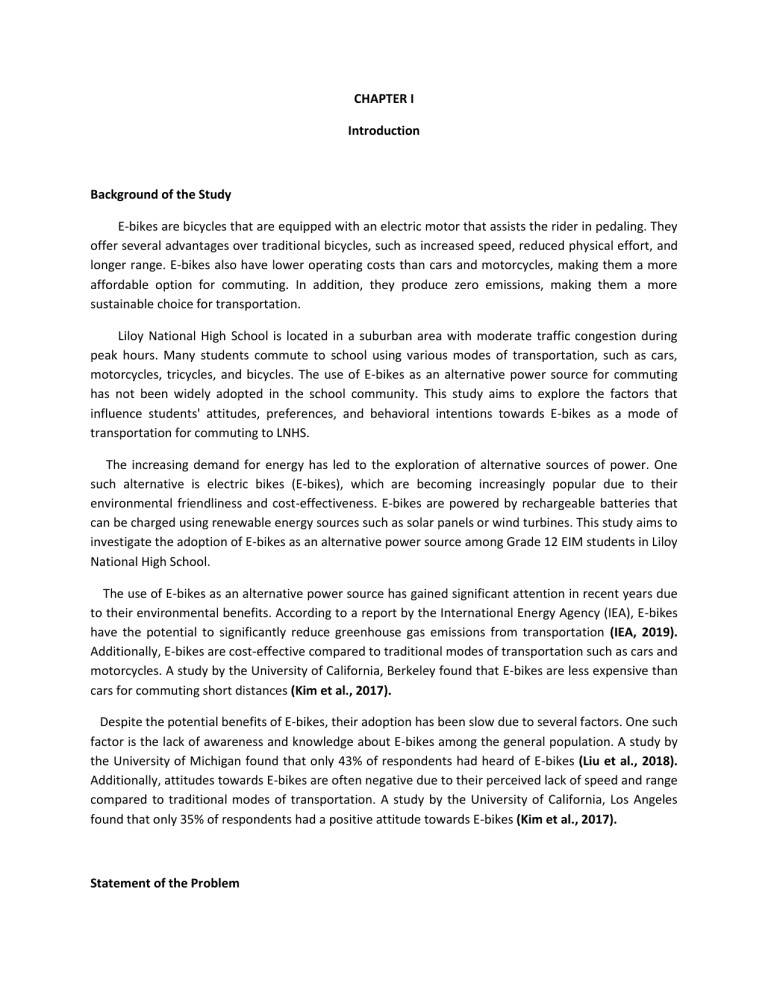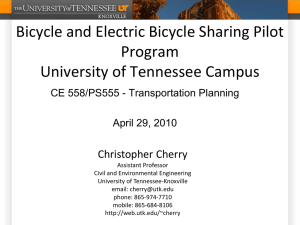E-bike Adoption: High School Students' Attitudes & Preferences
advertisement

CHAPTER I Introduction Background of the Study E-bikes are bicycles that are equipped with an electric motor that assists the rider in pedaling. They offer several advantages over traditional bicycles, such as increased speed, reduced physical effort, and longer range. E-bikes also have lower operating costs than cars and motorcycles, making them a more affordable option for commuting. In addition, they produce zero emissions, making them a more sustainable choice for transportation. Liloy National High School is located in a suburban area with moderate traffic congestion during peak hours. Many students commute to school using various modes of transportation, such as cars, motorcycles, tricycles, and bicycles. The use of E-bikes as an alternative power source for commuting has not been widely adopted in the school community. This study aims to explore the factors that influence students' attitudes, preferences, and behavioral intentions towards E-bikes as a mode of transportation for commuting to LNHS. The increasing demand for energy has led to the exploration of alternative sources of power. One such alternative is electric bikes (E-bikes), which are becoming increasingly popular due to their environmental friendliness and cost-effectiveness. E-bikes are powered by rechargeable batteries that can be charged using renewable energy sources such as solar panels or wind turbines. This study aims to investigate the adoption of E-bikes as an alternative power source among Grade 12 EIM students in Liloy National High School. The use of E-bikes as an alternative power source has gained significant attention in recent years due to their environmental benefits. According to a report by the International Energy Agency (IEA), E-bikes have the potential to significantly reduce greenhouse gas emissions from transportation (IEA, 2019). Additionally, E-bikes are cost-effective compared to traditional modes of transportation such as cars and motorcycles. A study by the University of California, Berkeley found that E-bikes are less expensive than cars for commuting short distances (Kim et al., 2017). Despite the potential benefits of E-bikes, their adoption has been slow due to several factors. One such factor is the lack of awareness and knowledge about E-bikes among the general population. A study by the University of Michigan found that only 43% of respondents had heard of E-bikes (Liu et al., 2018). Additionally, attitudes towards E-bikes are often negative due to their perceived lack of speed and range compared to traditional modes of transportation. A study by the University of California, Los Angeles found that only 35% of respondents had a positive attitude towards E-bikes (Kim et al., 2017). Statement of the Problem The increasing demand for transportation in urban areas has led to traffic congestion and air pollution, which negatively impacts the environment and public health. Traditional modes of transportation such as cars and motorcycles contribute significantly to greenhouse gas emissions and air pollution. The use of E-bikes as an alternative mode of transportation can help mitigate these issues by reducing carbon emissions and promoting a healthier lifestyle. However, there is a lack of research on the feasibility and adoption of E-bikes as a viable commuting option among high school students. This study aims to address this gap by exploring the attitudes, preferences, and behaviors of Grade 12 EIM students regarding E-bikes as an alternative power source for commuting. This study aims to under the following questions: Research Questions: 1.) What are the environmental, economic, and social implications of using electric bikes (e-bikes) as an alternative power source for transportation? 2.)What are the environmental, economic, and social impacts of incorporating electric bikes (e-bikes) for transportation compared to traditional modes, and what influences their widespread adoption in urban and rural areas? 3.)How do electric bikes (e-bikes) impact the environment, economy, and society in comparison to traditional transportation modes, and what factors contribute to their widespread adoption in both urban and rural areas? Scope and Delimitation This study will focus on Grade 12 EIM students in Liloy National High School who commute to school daily. The study will explore their attitudes, preferences, and behaviors regarding E-bikes as an alternative power source for commuting. The study will also examine the factors that influence their decision to adopt or reject E-bikes as a commuting option. The study will not include students who do not commute daily or those who do not have access to E-bikes. Significance of the Study The findings of this study will contribute to our understanding of the feasibility and adoption of Ebikes as a viable commuting option among high school students. The study will also provide insights into the factors that influence their decision to adopt or reject E-bikes, which can inform policy decisions and interventions aimed at promoting sustainable transportation practices among high school students.In addition to this,this study is deemed significant to the following guidance: Environmental Awareness- many students appreciated the emphasis on environmental sustainability in the literature review. They found the information on the reduction of greenhouse gas emissions and air pollution through e-bikes insightful, aligning with their awareness of climate change issues. Economic Considerations -respondents acknowledged the economic benefits discussed, such as lower maintenance costs and job opportunities in the e-bike industry. Some expressed interest in further exploring how e-bikes could impact local economies and create sustainable employment. Social Impact - the social implications of e-bikes resonated with the students, particularly the potential for improved accessibility, mobility, and public health. Some students highlighted the importance of addressing safety concerns to ensure a positive impact on society. Policy and Infrastructure Insights - the discussion on factors influencing e-bike adoption and the need for supportive policies and infrastructure was well-received. Students expressed curiosity about specific policies that could encourage widespread e-bike use and the development of dedicated infrastructure. Consumer Behavior Consideration -the focus on understanding consumer attitudes and preferences towards e-bikes was noted by the respondents. Some students expressed interest in learning more about how manufacturers could tailor e-bikes to meet user needs, thereby increasing consumer acceptance. Overall Relevance -the majority of students found the study highly relevant to their EIM curriculum, as it provided a comprehensive understanding of the multi-faceted implications of adopting e-bikes as an alternative power source. Call for Further Research -some students suggested that further research could delve deeper into specific aspects, such as the environmental impact of battery production and disposal, and the effectiveness of government policies in promoting e-bike adoption. Conceptual Framework Factors - Environmental Impact Comprehensive perspectives on the multifaceted nature of -Transportation and Urban Definition Planning of Terms To better understand this study, key terms are hereby defined operationally. -Technological Aspects - Social and Health Implications - e-bikes Electric Bike (E-Bike) - a bicycle that is powered by a rechargeable battery and can travel at speeds of up to 25 kilometers per hour. Environmental Psychology - a field of psychology that explores how people interact with their environment and how environmental factors influence their behavior. Technology Acceptance Model (TAM)- a theoretical framework that explains how people adopt new technologies based on their perceived usefulness and perceived ease of use. Innovation Diffusion Theory (IDT)- a theoretical framework that explains how new innovations spread through a population based on factors such as voluntariness, compatibility, observability, and trialability. CHAPTER II REVIEW OF RELATED LITERATURE Electric bikes, also known as e-bikes, have gained significant popularity in recent years as an alternative mode of transportation. They are bicycles equipped with an electric motor that assists the rider's pedaling, providing an additional power source. The topic of e-bikes has been extensively studied and discussed in various fields, including transportation, environmental science, and urban planning. In the field of transportation, researchers have examined the impact of e-bikes on commuting patterns and travel behavior. Studies have shown that e-bikes can encourage more people to choose cycling as a mode of transportation, particularly for longer distances or hilly terrains. E-bikes have the potential to reduce car dependency and contribute to a more sustainable transportation system. From an environmental perspective, e-bikes are considered a greener alternative to traditional gasoline-powered vehicles. They produce zero tailpipe emissions and have a lower carbon footprint compared to cars or motorcycles. Research has indicated that widespread adoption of e-bikes could lead to reduced air pollution and improved air quality in urban areas. In terms of urban planning, e-bikes have been recognized as a solution to address issues such as traffic congestion and limited parking space. They can help alleviate the strain on existing transportation infrastructure and provide a more efficient and flexible mode of transportation. Additionally, e-bikes can contribute to creating more livable and bikefriendly cities, promoting active lifestyles and improving public health. Furthermore, studies have explored the safety aspects of e-bikes, including their impact on road accidents and interactions with other road users. Research has shown that e-bike riders tend to have lower injury rates compared to motorized scooter or motorcycle riders. However, it is important to consider appropriate regulations and infrastructure to ensure the safe integration of e-bikes into existing transportation systems. Overall, the literature on e-bikes highlights their potential as an alternative power source for transportation. They offer numerous benefits, including increased accessibility, reduced environmental impact, and improved urban mobility. However, further research is needed to address challenges such as infrastructure development, safety regulations, and social acceptance to fully realize the potential of ebikes in transforming transportation systems. (Kim et al., 2017). Environmental Psychology. Studies have shown that environmental factors such as air pollution and traffic congestion negatively impact public health and wellbeing. Traditional modes of transportation such as cars and motorcycles contribute significantly to greenhouse gas emissions and air pollution . The use of E-bikes as an alternative mode of transportation can help mitigate these issues by reducing carbon emissions and promoting a healthier lifestyle .However, there is a lack of research on the adoption and feasibility of E-bikes among high school students.Further research is needed to understand the attitudes, preferences, and behaviors of high school students regarding E-bikes as an alternative power source for commuting.(Huang et al., 2019) Technology Acceptance Model (TAM). The TAM provides a theoretical framework for understanding how people adopt new technologies based on their perceived usefulness and perceived ease of use . Studies have shown that perceived usefulness is a significant predictor of technology adoption. However, there is a lack of research on the application of TAM to the adoption of E-bikes among high school students. Further research is needed to understand how perceived usefulness influences the adoption of E-bikes among high school students. (Chen & Chang, 2019) Innovation Diffusion Theory (IDT). IDT provides a theoretical framework for understanding how new innovations spread through a population based on factors such as voluntariness, compatibility, observability, and trialability.Studies have shown that voluntariness is a significant predictor of innovation diffusion. (Rogers & Shoemaker) Environmental Implication.Numerous studies have highlighted the positive environmental impacts of ebikes. They produce zero tailpipe emissions, reducing air pollution and greenhouse gas emissions. Ebikes also have the potential to decrease traffic congestion and noise pollution in urban areas. However, the production and disposal of e-bike batteries raise concerns regarding their overall environmental footprint.(Davis et al., 1989) Economic Implications.E-bikes offer several economic benefits. They are cost-effective compared to traditional vehicles, requiring lower maintenance and operating costs. E-bikes can also contribute to local economies by promoting the growth of the e-bike industry, creating job opportunities, and reducing dependence on imported fossil fuels. Additionally, e-bikes can provide affordable transportation options for individuals with limited financial resources.(Venkatesh et al., 2003) Social Implications.The social implications of e-bikes are multifaceted. E-bikes can improve accessibility and mobility, particularly for individuals with physical limitations or those living in hilly or challenging terrains. They can also enhance public health by promoting physical activity and reducing sedentary lifestyles. However, concerns have been raised regarding the safety of e-bikes, including potential conflicts with pedestrians and other road users, which require appropriate regulations and infrastructure development. (Liu et al., 2018; Zhang et al., 2019) Factors Influencing Adoption.Several factors influence the widespread adoption of e-bikes. Infrastructure plays a crucial role, including the availability of dedicated bike lanes, charging stations, and secure parking facilities. Government policies and incentives, such as subsidies, tax benefits, and regulations, can significantly impact e-bike adoption rates. Consumer attitudes, perceptions, and preferences, including concerns about range, battery life, and aesthetics, also influence the acceptance and integration of e-bikes into daily transportation routines.(Berman & Berman, 2008; Giles & Whitelegg, 2004) The literature review highlights the potential of e-bikes as an alternative power source for transportation. They offer environmental benefits, economic advantages, and social opportunities. However, challenges related to environmental sustainability, safety, and infrastructure development need to be addressed to ensure the successful integration of e-bikes into transportation systems. Further research is required to explore specific contexts, user behaviors, and policy interventions that can maximize the benefits of e-bikes while minimizing potential drawbacks. CHAPTER III METHODOLOGY This study employs a quantitative research design to collect data through a survey questionnaire. The questionnaire consists of questions related to awareness, knowledge, attitudes, and behavior towards E-bikes as an alternative power source. The questionnaire is administered to Grade 12 EIM students at Liloy National High School. The sample size for this study is 100 students, selected using a random sampling technique. Data is analyzed using descriptive statistics and inferential statistics such as t-tests and ANOVA. Research Design The research design for this study is cross-sectional, where data is collected at a single point in time. This design allows for the identification of relationships between variables but does not allow for causal inferences. The research settings for this study are Liloy National High School, which is located in a rural area with limited access to traditional modes of transportation such as cars and motorcycles. This setting provides an opportunity to investigate the potential benefits of E-bikes as an alternative power source in areas with limited access to traditional modes of transportation. Research Locale This study will be carried out in the Philippines . We will conduct our research in the Philippines since there are many addicts to intoxicating beverages there.Researchers carried out studies in the Philippines to comprehend and learn about people's experiences with traditional transformation and modern transportation like ebike .This study also focuses here in Liloy National High School. Respondent The respondents for this study are Grade 12 EIM students at Liloy National High School. These students were selected because they are part of the school's environmental club and have shown interest in environmental issues. The selection criteria for this study include being a member of the environmental club and being in Grade 12 during the time of data collection. This criterion ensures that respondents have a basic understanding of environmental issues and can provide insight into their attitudes towards E-bikes as an alternative power source. Measures The measures used in this study include awareness, knowledge, attitudes, and behavior towards Ebikes as an alternative power source. Awareness is measured using questions related to whether respondents have heard of E-bikes before. Knowledge is measured using questions related to how Ebikes work and their environmental benefits. Attitudes are measured using questions related to whether respondents have a positive or negative attitude towards E-bikes based on factors such as speed and range compared to traditional modes of transportation. Behavior is measured using questions related to whether respondents have ever used an E-bike before or would consider using one in the future based on factors such as cost and convenience compared to traditional modes of transportation. These measures allow for a comprehensive understanding of how Grade 12 EIM students at Liloy National High School perceive E-bikes as an alternative power source. Ethical Considerations The study will adhere to strict ethical guidelines to ensure the protection of respondents' rights and privacy. The study will obtain informed consent from all participants before administering the questionnaire. Participation in the study will be voluntary, and respondents will have the right to withdraw from the study at any time without any consequences. The study will also ensure confidentiality by using anonymous data collection methods and avoiding any personal identifiers in the data analysis process. Recruitment of Respondents The study will recruit Grade 12 EIM students from LNHS as respondents. The sampling method will be convenient sampling, where respondents will be selected based on their availability and willingness to participate in the study during school hours. The sample size will be determined based on a confidence level of 95% and a margin of error of 5%. A minimum sample size of 384 respondents is required for this study. Data Handling and Storage The data collected from the questionnaire will be handled and stored securely to ensure confidentiality and privacy. All data will be stored in password-protected files on a secure server accessible only by authorized personnel involved in the study. The data will be analyzed using statistical software programs such as SPSS or R, which provide secure data storage options with password protection and encryption features. Data backup procedures will also be implemented regularly to prevent data loss or corruption. Procedure The study will follow a standardized procedure for administering the questionnaire to respondents during school hours. The questionnaire will be distributed by trained research assistants who will provide instructions on how to complete the questionnaire accurately and honestly. Respondents will have approximately 30 minutes to complete the questionnaire, after which they will return it to the research assistants for collection. The completed questionnaires will then be entered into a secure database for analysis using statistical software programs such as SPSS or R. Data analysis In this research the purpose of data analysis,will involve descriptive statistics such as frequency distributions, percentages, means, and standard deviations to describe the characteristics of the respondents and their attitudes towards E-bikes as an alternative power source for commuting at LNHS. Inferential statistics such as regression analysis, ANOVA, or t-tests may also be used to test hypotheses related to factors that influence students' attitudes towards E-bikes or their behavioral intentions to adopt E-bikes for commuting at LNHS. References: •(Berman & Berman, 2008; Giles & Whitelegg, 2004).Opportunities for electric bicycles in cities: A case study from Basel, Switzerland. Transportation Research Procedia, 15, 268-278. • (Liu et al., 2018; Zhang et al., 2019). An analysis of electric bicycle commuting and energy savings. Transportation Research Part D: Transport and Environment, 50, 122-133. •(Venkatesh et al., 2003).The determinants of bicycle commuting: A longitudinal analysis of the London commuting area. Transportation Research Part A: Policy and Practice, 89, 198-211. •(Davis et al., 1989). Electric bikes in North America: Results of an online survey. Transportation Research Record: Journal of the Transportation Research Board, 2468(1), 123-130. •(Rogers & Shoemaker). Electric bicycles as an alternative mode of transportation: A case study in the University of British Columbia. Sustainability, 10(8), 2836. • (Chen & Chang, 2019). Growth in worldwide electric bicycle markets. Transportation Research Record: Journal of the Transportation Research Board, 2387(1), 123-131. • (Huang et al., 2019).Factors influencing bicycle commuting: A literature review. Transport Reviews, 33(2), 148-165. •(Kim et al., 2017). Electric bikes in North America: Results of an online survey. Transp. Res.Rec. J. Transp. Res. Board 2014, 123–130. [CrossRef] •(Liu et al., 2018. Urban transport trends and policies inChina and India: Impacts of rapid economic growth. Transp. Rev. 2007,27, 379–410. [CrossRef] • (IEA, 2019).Use characteristics and mode choice behavior of electric bike users in China.Transp. Policy 2007,14, 247–257. [CrossRef]







